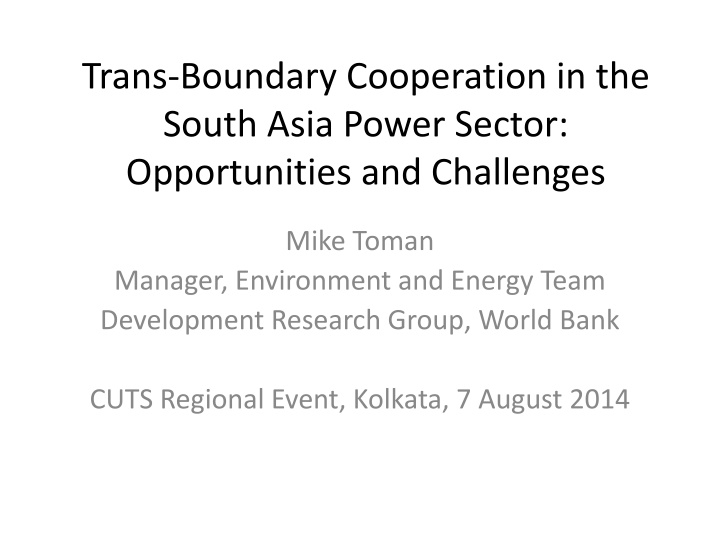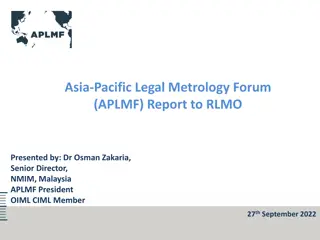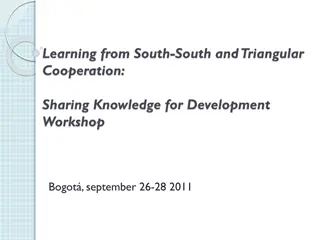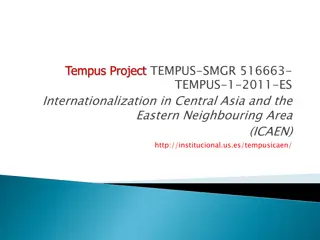Trans-Boundary Cooperation in South Asia Power Sector
This presentation, given at a regional event in Kolkata, discusses the opportunities and challenges of trans-boundary cooperation in the South Asia power sector. It explores the benefits of regional power integration, the analytical approach taken, baseline scenarios, potential impacts of regional cooperation on capacity growth and CO2 emissions, and the gains from cooperation and trade. The focus is on long-term gains, including the ability to utilize lower-cost generation and cleaner technologies through cooperation among countries like Bangladesh, Bhutan, India, and Nepal.
Download Presentation

Please find below an Image/Link to download the presentation.
The content on the website is provided AS IS for your information and personal use only. It may not be sold, licensed, or shared on other websites without obtaining consent from the author.If you encounter any issues during the download, it is possible that the publisher has removed the file from their server.
You are allowed to download the files provided on this website for personal or commercial use, subject to the condition that they are used lawfully. All files are the property of their respective owners.
The content on the website is provided AS IS for your information and personal use only. It may not be sold, licensed, or shared on other websites without obtaining consent from the author.
E N D
Presentation Transcript
Trans-Boundary Cooperation in the South Asia Power Sector: Opportunities and Challenges Mike Toman Manager, Environment and Energy Team Development Research Group, World Bank CUTS Regional Event, Kolkata, 7 August 2014
Disclaimer The results are preliminary and presented for the purpose of discussion only. 2
Why the interest in regional power integration? Short-term gains from ability of trade to relieve shortages Long-term gains from opportunity to utilize lower-cost generation at regional level Potential environmental gains to the extent trade facilitates greater utilization of cleaner generation technologies 3
What is our approach? Quantitative analysis with long-term electricity planning model to simulate impacts, potential gains of cooperation Full regional cooperation Partial cooperation (Bangladesh, Bhutan, India, Nepal) Qualitative analysis of institutional and policy issues 4
Summary of baseline scenario Regionally capacity grows by a factor of 4 Baseline capacity growth is very coal-intensive in Bangladesh, India, Pakistan Least-cost technology CO2 emissions also grow (4X regionally) 5
Regional cooperation/trade Major increases in hydro (~30GW with full regional cooperation), displacing significant additions to coal capacity But still a lot of coal drop in CO2 emissions relative to baseline is ~3% Significant additional investments in interconnection Allows more short-term capacity sharing as well as transmission capacity for major new hydro capacity 6
Gains from cooperation/trade Direct gains from trade are moderate in present value terms ~US$20B over 2015-2040, discounted at 8% (real rate fairly high) About 80% of this still is achieved with cooperation just among Bangladesh, Bhutan, India, Nepal Higher coal prices => significant additions to hydro capacity and trade, higher power costs Lower gas prices => some increase in domestic capacity and reduction in trade (in relative terms) 7
Why are the gains seemingly so modest? Trade is an incremental effect to the huge growth of regional capacity going forward All the increased hydro export to India in the analysis is ~5% of its total electricity use in 2040 Lying behind these discounted net benefit figures are some large positive impacts ~US$11B in additional generation and transmission CAPEX for trade facilitates ~US$28B in OPEX savings (undiscounted figures) 8
Why are the gains seemingly so modest? The baseline definition also matters We assume that current inefficiencies in domestic power sectors cannot be sustained; in particular, even without trade, persistent shortages are attenuated In work still to be done we are going to attempt to quantify the benefit of improved domestic sector performance relative to current BAU 9
So what about all this market efficiency business? Increases economic value in its own right But in addition, why interconnect very inefficient domestic power systems/markets? Longer-term cooperation and trade benefits would be even lower because regulatory distortions reduce value of investment, create risks that raise financing costs Conversely, improved domestic sector performance is a key part of reaping full gains from regional cooperation and trade 10
What are possibilities for achieving regional power cooperation and trade agreement in SAR? Experiences from many other regional arrangements with varying degrees of prescriptiveness are generally positive Even with country size asymmetries Even with disputes/conflicts among countries Can proceed in steps/gradually increasing number of participants and requirements But broader-scale, more formally organized coordination can yield considerably more benefit It takes time and serious dialogue 11
There are synergies between regional cooperation agreements and domestic policy reforms Broader success in regional agreements depends on significant power market liberalization, especially in pricing and access Want prices to reflect opportunity costs, provide effective signals for regional investments Prospects of increased gains from regional coordination may help strengthen case for admittedly difficult domestic reforms 12
How are gains from regional power cooperation and trade shared? No simple or unique answer If markets have been liberalized with competition among buyers and sellers ( B2B ), price = marginal cost will determine a sharing of gains If decision making is concentrated in relatively few hands such that market power can be exercised, importers are likely to capture more of the gains from trade They have more options than exporters, especially hydro 13
To summarize Increased regional power cooperation and trade can provide a valuable addition to broader efforts to improve sector performance Experience suggests agreement on (sub)regional power cooperation and trade is institutionally feasible for SAR, and can build incrementally The efficiency of domestic power systems/markets will have substantial influence on size and distribution of benefits from cooperation and trade as well as being important in its own right 14
A Regional Power Market Master Plan? Necessary technical requirements for high level of inter-operability Institutional structures for nondiscriminatory cross-border transmission access, loss sharing Including provision for equitable and transparent cross-border transmission siting and land access Also provision for efficient, non-predatory transmission pricing Further developed regional transmission plan Priority capacity expansions for increasing trade 15
A Regional Power Market Master Plan? Commercial provisions for contracting, dispute resolution Addition of electricity to the South Asian Free Trade Area agreement Plans for developing more elaborate regional power trading mechanisms Can build on positive experience with power trading in India, e.g. IEX Utilize regional dialogue among SAARC energy regulators 16
Thank you for your kind attention; I look forward to your questions and comments mtoman@worldbank.org 17


![READ⚡[PDF]✔ Emerging Space Powers: The New Space Programs of Asia, the Middle Ea](/thumb/21554/read-pdf-emerging-space-powers-the-new-space-programs-of-asia-the-middle-ea.jpg)




















